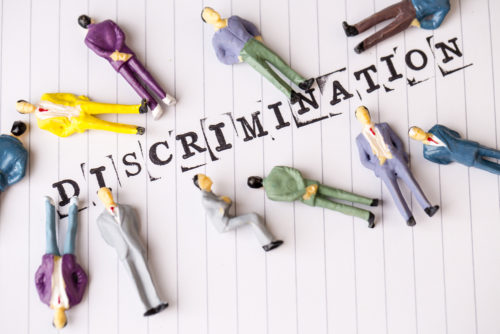Workplaces are intended to be equal, fair, and safe for everyone. Historically, it’s obvious that workplaces have not always been equal or equitable, and it’s true that offices have changed a lot (and for the better) over the past century.
However, there are still many workplaces that harbor hostility, bias, and discriminatory practices. Not all of these instances of discrimination may be blatant, but they can still have an extremely negative impact on workers, the company as a whole, and individuals both outside and within the business.
But what exactly is workplace discrimination? How can it be avoided, and how should you report it if you experience or witness cases of discrimination? Additionally, how can you be sure that you’re protected by the government if you’re a victim? Let’s dive into the legal waters surrounding workplace discrimination.
Table of Contents
What is Workplace Discrimination?
It is illegal for an employer with 15 or more employees to take adverse action against an employee or potential employee (in the case of hiring decisions) if that employee is a member of a protected class or category of persons. Additionally, it is unlawful for a business to retaliate against an individual who reports discrimination — meaning the business cannot fire, demote, withhold wages, or otherwise take an adverse career action against the victim.
These laws that protect individuals — commonly known simply as anti-discrimination laws — are enforced by the Equal Employment Opportunity Commission (EEOC) and are a part of the following federal regulations:
- The Civil Rights Act of 1964 (specifically Title VII), which protects people from experiencing discrimination in employment based on race, color of skin, religion, national origin, sex, as well as special protections because of pregnancy, childbirth, or medical conditions related to pregnancy or childbirth.
- The Age Discrimination in Employment Act (ADEA), which protects people over the age of 40 from experiencing targeted age discrimination in employment.
- The Americans with Disability Act (ADA) along with the Rehabilitation Act of 1973, both of which protects persons with disabilities.
- The Genetic Information Nondiscrimination Act (GINA) of 2008 (specifically Title II), which prohibits discrimination in employment based on genetic information.
- The Uniformed Services Employment and Reemployment Rights Act of 1994 (USERRA) (which is enforced by the Department of Labor instead of the EEOC), which protects future, present, and past uniformed military members from employment discrimination.
There are many different protections under these anti-discrimination laws, but the laws aren’t all-encompassing. For example, LGBTQIA employees and applicants are protected by federal law (specifically Title VII, according to an interpretation of the law in a 2012 and 2015 ruling), but some states may have contradictory laws, which can make filing a claim more difficult. As of 2018, only 20 states (as well as D.C., Guam, and Puerto Rico) have written laws within their Civil Rights Amendments protecting people from experiencing gender identity or sexual orientation discrimination in employment.
Additionally, many states have other unique protections for individuals. You can find out more about your state’s specific protections here.
It’s also important to note that those impacted by discrimination might not always be the intended target. For example, a person of color might overhear a racial joke shared between two fellow coworkers. Although not the intended victim, this overhearing employee still has legal grounds to report harassment or discrimination.
There are also times when discrimination can be experienced due to association, such as someone who befriends a person of protected class, is married to a person with a protected class, or is otherwise related to them and experiences discrimination due to that association. This sort of discriminatory treatment is very similar to bullying behaviors that might be experienced in the office, but are directly related to a protected status.
Discrimination Versus Harassment
Discrimination is often more broad than harassment, including both verbal and action-based adverse reactions against an employee due to their protected class. Discriminatory practices can be anything from being passed up for a raise or position due to your name, or it could be something more blatant such as experiencing harassment in the workplace in the form of racial slurs or sexual coercive comments. Harassment can often lead to hostile work environments and are the result of continued actions or verbal attacks against a person. In a broad sense, harassment is a form of discrimination that has occurred repeatedly or numerous times.
Types and Examples of Discrimination
There are many different types of discrimination, but the ones that are federally protected are listed below. There is also some common examples of each, and where you can find resources associated with those protections.
Age Discrimination
Age discrimination — also known as ageism — is unequal treatment given to people due to their age. Specifically, the federal protections given are for those over the age of 40 who may be experiencing targeted discrimination in the workplace. Some states extend those protections to younger individuals, as well.
The EEOC states that age discrimination is the act of treating an employee or applicant unfairly or unfavorably because of their age.
Examples of Ageism:
- A hiring manager passes over an applicant believed to be over the age of 40 because the hiring manager assumes the applicant will retire soon. (Also note that it is illegal to ask an applicant their age any time during an interview.)
- A job or internship posting specifies that they are looking for “young talent” or gives a specific age range when discussing desired applicants. This exclusion is unlawful according to the EEOC.
- While at work, a woman aged 59 (who has not mentioned any intentions to retire) is passed up for a promotion because her manager states: “We need someone for the long-term, not someone who will be retiring in 2 or so years.”
Disability Discrimination
Disability discrimination is the unfair and unequal treatment of persons with a disability due to their disability status. Protected by the ADA and Rehabilitation Act of 1973, the EEOC emphasizes that disability discrimination can be tied to chronic conditions (such as cancer), as well as physical disabilities, psychological disabilities, as well as other impairments (such as mental, visual, verbal, or hearing). Individuals are also protected if they’ve had a history of disability, such as if their condition has gone into remission.
All employers are required by law to provide reasonable accommodations to employees or job applicants who have a disability, unless doing so would be considered “undue hardship” to the employer, meaning it would cause significant difficulty or expense.
These protections also extend to persons who may be related to a person with a disability. The example given by the EEOC is that a woman is married to a man with a disability; this woman is also protected from disability discrimination.
Examples of Disability Discrimination:
- Employees made rude gestures or slurred speech at an individual who has a speech impediment. This could also classifies as harassment if it were to happen repeatedly.
- An employer holds an important meeting within an office that is not compatible with a wheelchair, which forces an employee bound to a wheelchair to miss the meeting, and thus could have a negative impact on their career.
- An employee is threatened with termination because they missed work due to their chronic illness.
- An applicant is passed over for the position they were qualified for, simply because the business didn’t want to invest in accommodating their needs.
Employment Discrimination
Employment discrimination is directly related to the hireability of people with a protected class. It is unlawful for businesses to pass over a qualified applicant due to their protected class. Unfortunately, this sort of discrimination is still common, but can be extremely difficult to prove.
Example of Employment Discrimination:
A common example is racial discrimination experienced during hiring decisions. The Harvard Business Review covered this topic in detail in 2017, stating: “Broadly, our meta-analysis of callback rates from all existing field experiments showed evidence of discrimination against both black and Latino applicants. Since 1990 [covering the past 25 years] white applicants received, on average, 36% more callbacks than black applicants and 24% more callbacks than Latino applicants with identical résumés.”
In these scenarios, it can be difficult to prove bias and pursue a discrimination charge with the EEOC. However, you can always contact a lawyer to receive appropriate legal advice in your scenario.
Genetic Information Discrimination
Genetic information discrimination directly refers to an employee’s genetic predisposition or family history related to medical conditions or diseases. Employers are prohibited from requesting or discriminating against an employee based on genetic information; both of the individual as well as their family members and potential offspring.
This form of discrimination is fairly new (it was first enforced in November, 2009), but is still vitally important in protecting individuals. As the EEOC explains:
“Title II of GINA prohibits the use of genetic information in making employment decisions, restricts employers and other entities covered by Title II (employment agencies, labor organizations and joint labor-management training and apprenticeship programs – referred to as “covered entities”) from requesting, requiring or purchasing genetic information, and strictly limits the disclosure of genetic information.”
GINA also protects an individual from being denied benefits due to their genetic information. If you feel you have been unfairly treated due to a genetic condition, consult the EEOC’s website for further information about your protection. Additionally, you can always contact your local EEOC office.
Examples of Genetic Discrimination:
An employee cannot be denied medical benefits from their employer due to their genetic information or family medical history. There are also very particular requirements for employers on obtaining genetic information (such as for voluntary health screenings). Some examples of genetic discrimination might include:
- An office is offering health screenings for their employees, but when some employees refuse the health screening, they are threatened with termination.
- A company is concerned about the repetitive nature of their employee’s work, and asks doctors to screen their employees for certain conditions (such as carpal tunnel syndrome). However, this is in severe violation of privacy and doctor-patient confidentiality. The EEOC prosecuted a case similar to this in 2001.
- An employee mentions to her supervisor that her mother had recently passed away due to Huntington’s Disease (a rare and severe genetic condition), and the employee expressed concerns that she might develop the condition sometime in her life. Within a week of mentioning this, the employee was let go of the company, and she feared her discussion with her supervisor might have been the cause.
Military and Veteran Status Discrimination
All members of the military (from future members to veterans) have legal employment protections that are enforced by both the EEOC (in cases of veterans with disabilities via the ADA) as well as the US Department of Labor (DOL) via USERRA. Employees that have any prior or upcoming military service (such as recently signed members) are protected under USERRA from experiencing any form of employment discrimination: whether that is being passed up for a raise because of upcoming leave, being denied reemployment after serving, or experiencing direct harassment due to their military relationship.
Additionally, veterans with disabilities are protected under the ADA from receiving discrimination based on a disability, and employers are required to make reasonable accommodation to meet their needs.
Examples of Military or Veteran Discrimination:
- A veteran who experiences PTSD is called a slur (such as “crazy” or “psycho”) repeatedly by their boss after experiencing PTSD episodes.
- An employee is promised a job after they return from the military, but when they are released from service the business denies them the position back, despite them being qualified for the job and a position being available. The hiring manager states they need a more reliable employee, and not one that will leave for military services in the future.
To find out more about your rights under USERRA, visit the DOL website detailing your protections and the obligations expected of employers.
National Origin Discrimination
National origin discrimination involves the adverse treatment of employees and applicants simply based on their nation of origin, their accent or ethnicity, as well as adverse action based on the assumption that they’re from another country or of a certain ethnicity (even if they are not).
The EEOC also states that employers can only request fluency in English if it is a necessary requirement for the job, but that applicants cannot be denied employment because of their accent (unless it seriously interferes with their performance on the job).
Examples of Discrimination Based on National Origin:
- An employee of Asian decent is born and raised in America, but is continually asked by their fellow employees what their nation of origin is, and is harassed for being of Asian decent.
- An applicant with a slight accent is denied a job as a content writer because of their accent, despite the fact that they speak and write fluent English.
- A supervisor at a call center constantly berates a singular employee for having an accent, stating they don’t want the customers to think they’re in India when in fact their in the midwest.
- An employee is teased continually for marrying an immigrant from the Middle East, and coworkers joke that the marriage was for citizenship only. (Again, relationships to protected classes are also protected by anti-discrimination laws.)
Pregnancy Discrimination
Pregnancy discrimination refers to the act of treating a pregnant employee or applicant unfairly due to a current pregnancy or childbirth, as well as due to any pregnancy related medical conditions.
Specifically, the protections are outlined in the Pregnancy Discrimination Act (PDA) and enforced by the EEOC. The EEOC states that employers must provide temporary disability leave or accomodations to any employee that is pregnant or experiencing a related medical condition to pregnancy. Essentially, the company must treat any pregnant employee in the same way that they would treat any other temporarily disabled employees.
Additionally, the EEOC notes: “Further, under the Family and Medical Leave Act (FMLA) of 1993, a new parent (including foster and adoptive parents) may be eligible for 12 weeks of leave (unpaid or paid if the employee has earned or accrued it) that may be used for care of the new child. To be eligible, the employee must have worked for the employer for 12 months prior to taking the leave and the employer must have a specified number of employees. [see here for more]”
Examples of Pregnancy Discrimination:
- A new father is denied paid paternity leave despite meeting the federal requirements, and will have to take unpaid time off — even though new mothers are allowed paid maternity leave with the same company.
- A pregnant woman is expected to perform the same physically demanding duties as she was before her pregnancy, or she could face termination. The employer will not accommodate her needs, and thus is discriminating against her temporary disability.
- A supervisor repeatedly makes light of a pregnant employee, and states that they are simply being “hormonal” when they have disagreements.
Racial Discrimination
Racial discrimination is adverse reactions taken against an employee or an applicant due to their race, as well as any associated characteristics with that race (such as facial features, natural hair, and skin color). Employers cannot enforce rules that place an unfair bias on applicants or current employees that have specific racial characteristics, unless those rules are completely necessary for the job (such as requiring hair/beard nets in a kitchen).
Examples of Racial Discrimination:
- An employee is repeatedly called racial slurs due to the color of their skin by other employees, and the manager refuses to address it.
- An applicant is passed over for a job because of their natural hair (for example: cornrows, dreadlocks, weave, or afro), and the hiring manager states it would be a distraction in the office.
- An employee of color that has been with the company for years is making less than other works despite providing quality work for the company. When the employee asks about it, they find that other white workers have been offered higher wages, despite not providing the same caliber of work. Additionally, the employee can prove other instances of racial bias on the part of their manager or supervisor.
Religious Discrimination
Religious discrimination refers to the act of treating employees or applicants unfairly due to their religious beliefs. This could be either as members of an organized religion (such as Hinduism, Christianity, Muslim, etc), or it could refer to those that have sincerely held beliefs, ethics, and moral standards. Additionally, employees cannot be forced to participate (or not participate) in a religious activity on condition of employment.
The EEOC notes that employers must be able to make reasonable accommodations for employees of every religion, as long as those accommodations do not place undue hardship or effect the efficiency of the employer on the job. Specifically, the EEOC notes: “An accommodation may cause undue hardship if it is costly, compromises workplace safety, decreases workplace efficiency, infringes on the rights of other employees, or requires other employees to do more than their share of potentially hazardous or burdensome work.”
Examples of Religious Discrimination:
- A Muslim employee is forbidden from praying in the office, despite the fact that scheduled prayers are an important part of that religion and it does not interfere with any work.
- A Hindu employee at a supermarket is regularly scheduled to have as little customer interaction as possible because the manager fears the employee will face discrimination at the hands of customers. The employee, however, regularly enjoys working with customers and has not requested these shift assignments.
- A supervisor in a commercial office requests that everyone on the team join him in a Christian-led prayer, and when some employees refuse, he threatens them with termination.
Sex and Gender Discrimination
Sex and gender discrimination refers to the unfair treatment of an employee or applicant due to their gender. This can includes transgender and gender-nonconforming employees or applicants, as any discriminatory action taken against someone specifically because of their gender assignment can be interpreted as a federal violation of Title VII of the Civil Rights Act of 1964.
Some of the most recognizable forms of sex and gender discrimination are pay inequality and sexual harassment. However, these protections can also extend to sexual orientation and gender identity as interpreted by federal ruling, despite any local laws that might try to contradict those protections.
Examples of Gender Discrimination:
- A transgender woman is applying to a job but is treated rudely and misgendered during the interview. Despite her qualifications, she is passed up for the job. If she can prove bias, she would have a case for gender discrimination with the EEOC.
- A woman finds she is paid less than her male counterparts, despite working with the company for longer and providing exceptional work. When she brings it up to her male boss, her concerns are ignored, and she is told she’s being “too bossy.”
- A gay male employee working in a predominantly female-led industry is repeatedly asked inappropriate sexual questions from his female coworkers, and his supervisor doesn’t put a stop to the behavior.
- Male employees with a tech firm regularly make derogatory remarks about women, and female employees feel alienated in the office. Although the women aren’t directly targeted, they are still impacted by the behavior and could have a case with the EEOC.
- An employee with a deli market regularly uses homophobic slurs to talk about customers they don’t like. A lesbian employee finds this offensive and brings it up to her supervisor, but is ignored because it’s considered “kitchen talk” and not that severe in the supervisor’s opinion.
Weight Discrimination
Weight discrimination is the unfair treatment of employees or applicants due to their physical size. Because weight is so closely related to genetic makeup and medical health, weight discrimination could fall under protections created by Title II of GINA as well as protections extended from the ADA. However, there are no specific federal guidelines prohibiting weight bias in the workplace.
The EEOC does state the following on the matter:
“Height and weight requirements tend to disproportionately limit the employment opportunities of some protected groups and unless the employer can demonstrate how the need is related to the job, it may be viewed as illegal under federal law. A number of states and localities have laws specifically prohibiting discrimination on the basis of height and weight unless based on actual job requirements. Therefore, unless job-related, inquiries about height and weight should be avoided.”
If you do experience weight discrimination in the office, contact an EEOC field office or an attorney for legal advice specific to your situation.
Types of Discrimination Claims
If you believe you have been the victim of discriminatory action or treatment, there are a few types of claims that you can consider that might fit your experience.
Discriminatory Intent or Treatment
This type of claim refers to when an employee believes they were treated unfairly or worse by the employer due to their protected class or category. In these cases, there was intention on behalf of the employer to alienate the victim.
Disparate Impact
This type of claim refers to unintentional unfair treatment of a protected class. This could mean that hiring requirements for a position or office rules were seemingly neutral, but actually had a disproportionately negative impact on applicants of a protected class. For example, business cannot enforce straight or trimmed hairstyles in the office, as it could alienate people of color whose natural hair might not fit within the standards set.
Retaliation and Intimidation
Retaliation claims refer to specific instances when a victim believes they were retaliated against despite engaging in conduct that is protected by federal law: such as reporting a safety hazard, or bringing awareness to harassment or discrimination in the office. Retaliation can be in the form of a pay cut, withholding pay, demotion in position, or termination (firing) of the employee. Additionally, if an employee is threatened with retaliation from their employer (but it doesn’t happen), they are also protected as that form of intimidation is also illegal.
Proving Discrimination at Work
There are a few ways you can prove discrimination has occurred at your place of work. The most powerful form of evidence is known as direct evidence, and this is normally in the form of statements that directly relate to adverse action taken against you because of your protected class. However, direct evidence can be difficult to obtain, and many instances of discrimination are more subtle.
The other form of evidence is known as circumstantial evidence, which refers to creating a presumption of discrimination. Circumstantial evidence is a bit trickier to prove, as many managers, HR representatives, and company spokesmen are trained to avoid exposing their bias. However, there are some questions you can ask — this is referred to as the “McDonnell-Douglas Test”:
- Are you a member of a protected class or category?
- Were you qualified for the position you applied to or occupy currently/in the past?
- Did your employer take adverse action against you? (Adverse action includes being passed over for a job, demoted from your position, terminated/fired, loss in compensations, or other conditions of employment.)
- Were you replaced by a person who is not in your protected class?
If you can prove these things, then there can be an assumption created that shows your employer took an adverse action against you because of your protected class. This test isn’t a guaranteed guilty verdict, but it can be used to help build your case. Additionally, this test can be modified and adjusted over time, depending on your circumstance and any future federal rulings.
Some additional questions you can ask yourself or consider include:
- Were you treated differently than other employees because of your protected class?
- Have other employees who are also in your protected class raised concerns about management or facing discrimination on the job?
- Are the circumstances related to your treatment proof of a hostile work environment?
- Were you the only person of that protected class employed at the company? Or were there very few other members of that protected class employed there?
- Have you noticed other employees of your protected class facing negative treatment or adverse action at the hands of your employer?
If you do believe you have faced discrimination at the hands of your employer, be sure to contact a qualified attorney or EEOC field office to help you understand your rights and responsibilities when filing a claim. Keep detailed notes of your experiences, and be prepared for some challenges ahead that you might have to face.
In the end, proving discrimination can be extremely difficult, but the work you put into the process is important. Our world isn’t perfect, but every little fight against bias will help make the future better for everyone.
Image Source: https://depositphotos.com/





